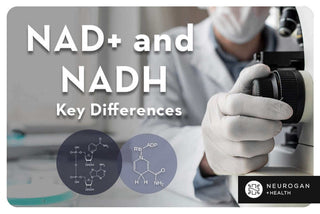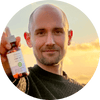NAD exists in two forms: NAD+ and NADH. NAD+ (nicotinamide adenine dinucleotide) and NADH (reduced nicotinamide adenine dinucleotide) are two forms of the same coenzyme, NAD (no plus).
Together, these two forms of NAD play a critical role in many of the biological processes within a cell, from energy production to DNA repair, gene expression, and much more.
NAD+ is the oxidized form of the molecule, while NADH is the reduced form.
The ratio of NAD+ to NADH is important for maintaining proper cellular function, and disruptions to this ratio can contribute to age-related decline and disease.
What Is NAD to NADH?
NAD stands for nicotinamide adenine dinucleotide, and it's a coenzyme that exists in all our cells.
NAD exists in two forms: NAD+ and NADH. And together, NAD+ and NADH are called a "redox couple." Its two molecule forms NAD+ and NADH acts as a helper in many important enzymatic reactions in the body, which can include:
-
Energy production: converting food into ATP
-
Control gene expression: how genes are turned on or off in response to different signals in the body
-
DNA repair: remove damaged DNA and replace it with new DNA
-
Immune function: regulates the activity of immune cells
You can think of a redox couple like players in a game of catch. And the game itself is called "redox reactions."
In this game, the ball represents elections, and the two players are NAD+ and NADH—the redox couple.
One person throws the ball (electrons) to the other person. This player becomes "oxidized" because they no longer have the ball, but are now primed to catch a ball.
The second player catches the ball (electrons) and becomes "reduced" because they now have the ball (gains electrons). But their hands are full and can't catch any more balls. They'll need to throw what's in their hands to keep the game going.
-
Oxidized = lose elections
-
Reduced = gains electrons
The two molecules then switch roles and the process repeats.

The balls (electrons) is what fuels the chemical reactions in the mitochondria, and without a steady supply of NAD, the mitochondria can't properly convert the nutrients from foods into usable energy or participate in cellular signalling.
What Is NAD+ or Plus?
NAD+ is the oxidized form of NADH. It's also considered to be the biologically functional form of NAD because it has catalytic properties (facilitates chemical reactions).
The plus sign indicates that it has a positive charge, meaning it lost electrons.
But it doesn't stay in this oxidized form.
During cellular respiration, NAD+ accepts electrons and a hydrogen ion to turn into NADH.
This back and forth between the same molecule, which is refed to as the electron transport chain, contributes to adenosine triphosphate (ATP) production.
NAD+ is also involved in DNA repair, gene expression, and other important cellular processes.
In these functions, NAD+ serves as a cofactor for enzymes that modify DNA, regulate gene expression, and repair damaged DNA.
One interesting feature of NAD+ is that it is believed to be unable to cross the mitochondrial membrane, which may have important implications for its role in cellular metabolism and whether or not NAD+ IV infusion is a valuable way support NAD levels long term [1].
What Is NADH?

NADH is the reduced form of the coenzyme NAD+, meaning that it can transfer electrons to other molecules.
Specifically, NADH is involved in the electron transport chain, which is a series of redox reactions that occur in the inner mitochondrial membrane that ultimately generate ATP (cell's fuel), a process known as oxidative phosphorylation.
Overall Difference Between NAD+ And NADH?
NAD+ and NADH are virtually the same molecule (with some small differences).
NAD+ is the oxidized form of NAD, which means it loses two electrons (in the form of hydrogen atoms) and a proton (hydroden ion) during a redox reactions.
NADH is the reduced form of the NAD molecule, which means it gains two electrons and hydrogen proton.
NAD+ and NADH are essentially two halves of a whole. However, there isn't an always a equal NAD+ and NADH ratio.
The ratio can vary on the metabolic state of the cell. For instance, there is a higher concentration of NADH during cellular respiration than NAD+ [2].
The NAD+ and NADH ratio is important because it can affect the balance of many metabolic processes in the body. The mitochondrial NAD+/NADH ratio can influence the activity of enzymes, and as a result, the many biological processes that occur within the cell.
An large imbalance in the ratio can lead to disruptions in these processes, which can contribute to a variety of health conditions [3].
Therefore maintaining a healthy NAD+ to NADH ratio is key for one's overall health and wellness.
Commons Questions about Both NAD & NADH
1. What are NAD+ and NADH?
NAD+ and NADH forms of NAD. These two forms of the same molecule are what fuel many of the chemical reactions within the cell that play important roles in cellular metabolism, including energy production and DNA repair.
2. What is the difference between NAD+ and NADH?
NAD+ is an oxidized form of the coenzyme NAD molecule, while NADH molecules are the reduced form. NAD+ can accept electrons, while NADH can donate electrons. The cell requires both in order to complete a range of biological processes.
3. How does NAD+ become NADH?
NAD+ becomes reduced to NADH when it accepts two electrons and a hydrogen ion (proton) from another molecule.
During a redox reaction, NAD+ accepts two electrons and a hydrogen ion from a substrate molecule, which becomes oxidized in the process. This reaction converts NAD+ to its reduced form, NADH, which gains two electrons and a hydrogen ion.
References:
-
Engelking, L. R. (2015). Oxidative Phosphorylation in. Textbook of Veterinary Physiological Chemistry, 219-224.
-
Yang, Y., & Sauve, A. A. (2016). NAD+ metabolism: Bioenergetics, signaling and manipulation for therapy. Biochimica et Biophysica Acta (BBA)-Proteins and Proteomics, 1864(12), 1787-1800.
-
Liao, B., Zhao, Y., Wang, D., Zhang, X., Hao, X., & Hu, M. (2021). Nicotinamide mononucleotide supplementation enhances aerobic capacity in amateur runners: a randomized, double-blind study. Journal of the International Society of Sports Nutrition, 18(1), 54.
-
Broman-Fulks, J. J., Canu, W. H., Trout, K. L., & Nieman, D. C. (2012). The effects of quercetin supplementation on cognitive functioning in a community sample: a randomized, placebo-controlled trial. Therapeutic Advances in Psychopharmacology, 2(4), 131-138.




